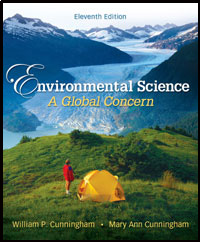 
Environmental Science, 11th Edition (Cunningham)Feature Summary- Google Earth placemarks: Google Earth is an online program that provides interactive satellite imagery of the earth and will help students understand the geographic context of places and topics in the text. Wherever students see a Google Earth icon in the text, they can go to our website (http://wwww.mhhe.com/cunningham11e) to find a Google Earth placemark that will take them to the specific place being discussed. Students can zoom in to see amazing detail and zoom out to gain a global perspective.
- Data Analysis Exercises: A Data Analysis box has been included at the end of every chapter. These exercises ask students to graph and evaluate data, to practice looking at numbers and graphs, and to critically analyze what they see.
- Case studies and boxed readings: A majority of the case studies and boxed readings in this edition are focused on current events and success stories that display the global progress being made in environmental protection.
- Learning outcomes and other pedagogical tools: Chapter material includes Learning Outcomes presented at the beginning of each chapter and a Reviewing Learning Outcomes section at the end of each chapter. These Learning Outcomes are connected to the major headings of each numbered section within the chapter to help students better organize the content and their study. Each chapter also includes a conclusion, which summarizes major points, and a Practice Quiz to aid in understanding key concepts from the chapter.
- Global Concern Theme: The text's "global concern" theme is critical because students need to understand that environmental problems and solutions are relevant to all nations and countries and not specific to just North America.
- Critical Thinking Emphasis: Throughout the text, the skill of critical thinking is emphasized by asking the reader to view all sides of an issue and to make informed, rational decisions based on ethical values.
-Case Studies, "Exploring Science" boxes, "What Do You Think?" essays (many with "Ethical Considerations" attached), and "Think About It" boxes give students real-life examples to evaluate and a chance to practice critical thinking skills and formulate reasoned opinions. These boxes are carefully planned to build upon chapter content and are long enough to present important, real information. -End-of-chapter "Questions for Critical Thinking" are designed to stimulate creative, analytical thinking and to serve as a springboard for class discussions.  |  |
|





